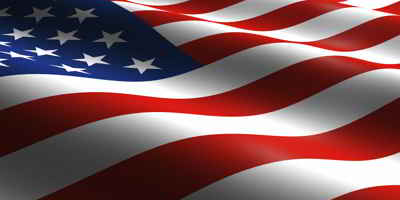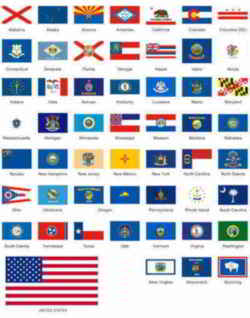

California Symbols
California State Flag
The Bear Flag
"Lone star reference to the lone Star of Texas"
Adopted in 1911.
The Bear Flag is the official flag of the state of California. The precursor of the flag was first flown during the 1846 Bear Flag Revolt and was also known as the Bear Flag. The flag was designed by William Todd on a piece of new unbleached cotton. The star imitated the lone star of Texas. A grizzly bear represented the many bears seen in the state. The word, 'California Republic' was placed beneath the star and bear. The Bear Flag was replaced by the American flag. It was adopted by the 1911 State Legislature as the State Flag. "The first official version of the Bear Flag was adopted by the California State Legislature and signed into law by Governor Hiram Johnson in 1911 as the official state flag.
The California State Flag
California Flag of 1911
Historic Bear Flag raised at Sonoma on June 14, 1846, on June 14, 1846, a small band of settlers marched on the Mexican garrison at Sonoma and took the commandant, Mariano Vallejo, prisoner, They issued a proclamation which declared California to be a Republic independent of Mexico. This uprising became known as the Bear Flag Revolt after the hastily designed flag depicting a grizzly bear and a five pointed star over a red bar and the words "California Republic." The grizzly bear was a symbol of great strength while the lone star made reference to the lone Star of Texas. The flag only flew until July 9, 1846 when it was learned that Mexico and the United States were already at war. Soon after, the Bear Flag was replaced with the American flag. It was adopted as the State Flag by the State Legislature in 1911.
According to the California Blue Book:
"The flag was designed by William Todd on a piece of new unbleached cotton. The star imitated the lone star of Texas. A grizzly bear represented the many bears seen in the state. The word, 'California Republic' was placed beneath the star and bear. The Bear Flag was replaced by the American flag. It was adopted by the 1911 State Legislature as the State Flag. "
Unfortunately, the original Bear Flag, held by the Society of California Pioneers perished in the Great Earthquake and Fire of 1906.
In 1953, the design and specifications for the state flag were standardized in a bill signed by Governor Earl Warren. The Californian state flag is often called the "Bear Flag" and in fact, the present statute adopting the flag, Gov. Code 420, states: "The Bear Flag is the State Flag of California."
California Flag Law
Government Code of the California Codes, section 420-429.8.
GOVERNMENT CODE.
TITLE 1. GENERAL.
DIVISION 2. STATE SEAL, FLAG AND EMBLEMS.
CHAPTER 2. STATE FLAG AND EMBLEMS.
SECTION 420-429.8.
420.
The Bear Flag is the State Flag of California. As viewed with the hoist end of the flag to the left of the
observer there appears in the upper left-hand corner of a white field a five-pointed red star with one point
vertically upward and in the middle of the white field a brown grizzly bear walking toward the left with
all four paws on a green grass plot, with head and eye turned slightly toward the observer; a red stripe
forms the length of the flag at the bottom, and between the grass plot and the red stripe appear the words
CALIFORNIA REPUBLIC.
Dimensions, excluding heading and unfinished flag ends: The hoist or flag width is two-thirds of the fly or flag
length; the red stripe width is one-sixth of the hoist width. The state official flag hoist widths shall
be two, three, four, five, six and eight feet. The diameter of an imaginary circle passing through the points
of the star is one-tenth of the fly length; the distance of the star center from the hoist end is one-sixth
of the fly length and the distance from the star center to the top of the flag is four-fifths of the star-center
distance from the hoist end. The length of the bear diagonally from the nose tip to the rear of right hind
paw is two-thirds of the hoist width; the height of the bear from shoulder tip vertically to a line touching
the bottoms of the front paws is one-half the length of the bear; the location of the bear in the white
field is such that the center of the eye is midway between the top and bottom of the white field and the
midpoint of the bear's length is midway between the fly ends. The grass plot in length is eleven-twelfths
of the hoist width and the plot ends are equidistant from the fly ends; the average width of the plot between
the rear of the left front paw and the front of the right rear paw is one-tenth of the grass plot length.
The height of the condensed gothic letters, as shown on the representation, is one-half of the red stripe
width and they occupy a lineal space of two-thirds of the fly length with the beginning and ending letters
of the words equidistant from the fly ends.
Colors: The following color references are those of the Textile Color Card Association of the United States,
Inc., New York; the colors on the flag are to be substantially the same as these color references. White--of
the white field, front of bear's eye, and on the bear's claws is White, cable number 70001. Red--of the
red stripe, the star, and the bear's tongue is Old Glory, cable number 70180. Green--of the grass plot is
Irish Green, cable number 70168. Brown--of the bear is Maple Sugar, cable number 70129. Dark brown--of the
bear outline, paws, shading, fur undulations, iris of the eye, the 12 grass tufts in the grass plot, and
the letters is Seal, cable number 70108.
The general design and the details of the Bear Flag, excluding colors, shall correspond substantially with the following
representation:
This shall be the official State Flag of all state, county, city and town agencies. The flags now issued or in use
shall continue in service until replacement is required.

The Flags of the US.





